The early morning in Hakone (箱根) was very cold when we woke up. After the wash-up, we prepared to check-out of our Airbnb house for the travel to the next destination, Kyoto (京都). We brought our luggage along and walked a short distance to the nearby Ohiradai Station (大平台駅) to catch the Hakone Tozan Train to Hakone-Yumoto Station (箱根湯本駅).
 |
| Ohiadai Station |
 |
| Ohiadai Station |
Luckily the interior of the train is quite spacious and still relatively empty in the early morning, which we could accommodate the big luggage we had with us.
 |
| Interior of Hakone Tozan Train |
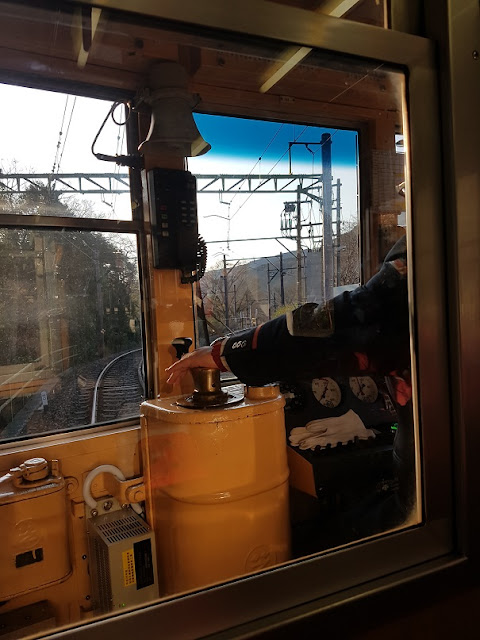 |
| Hakone Tozan Train Driver Cabin |
As the train travelled towards Hakone-Yumoto Station (箱根湯本駅), we could enjoy the green mountainous scenery along the way.
Once we reached Hakone-Yumoto Station (箱根湯本駅), we immediately change to another train bound for Odawara Station (小田原駅).
 |
| Interior of Hakone Tozan Train between Hakone-Yumoto and Odawara Stations |
As we still had some time when we arrived at Odawara Station (小田原駅), we bought some bread and hot drinks from the shop as our breakfast, before we board our Shinkansen Hikari train to Kyoto Station (京都駅).
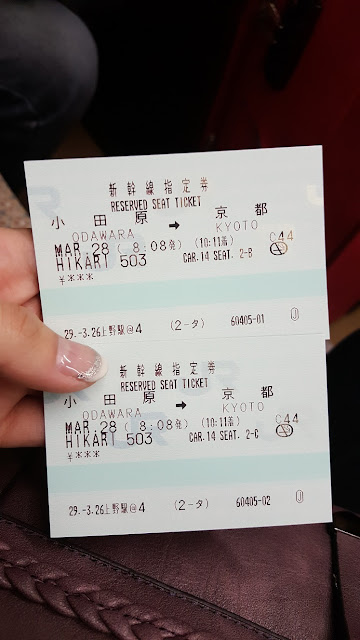 |
| Reserved tickets for our Hikari Shinkansen ride |
The train ride from Odawara Station (小田原駅) to Kyoto Station (京都駅) will take around 2 hours. So as usual, we would take this opportunity to catch some sleep on the train ride. After some time while I was in a state of half asleep and awake mode, I saw something on the right outside the window, it was Mount Fuji! The train was passing by an area of low lying residential area, which the view of the great mountain was unobstructed under the clear blue sky.
 |
| Magnificent view of Mount Fuji from Shinkansen |
We were really fortunate to see this famous landmark of Japan, especially that we had missed the view of it the day before at Lake Ashi (芦ノ湖) and Owakudani (大涌谷) due to cloudy weather.
Kyoto Station (京都駅)
Kyoto (京都) was the capital of Japan and the residence of the Emperor for more than a thousand years, until the Meiji Restoration in 1868 when the capital was shifted to Tokyo. As such, there is a lot of historical and cultural significance attached to the city. Today, the Imperial Palace and the numerous temples (including those listed in the UNESCO World Heritage Site, under the designation of the Historic Monuments of Ancient Kyoto) are popular tourist attractions in Kyoto. Kyoto is also the birthplace of green tea (also known as Matcha) drinking culture in Japan, which visitors could see many drinks, snacks and desserts related to Matcha.
Kyoto Station (京都駅) is a major transportation hub in the region, serving as an interchange between Shinkansen, local trains, buses and subway. In addition, there's also several large shopping malls and departmental stores connected to it, making it a like big maze for first time visitors like us when we arrived there.
 |
| Inside Kyoto Station |
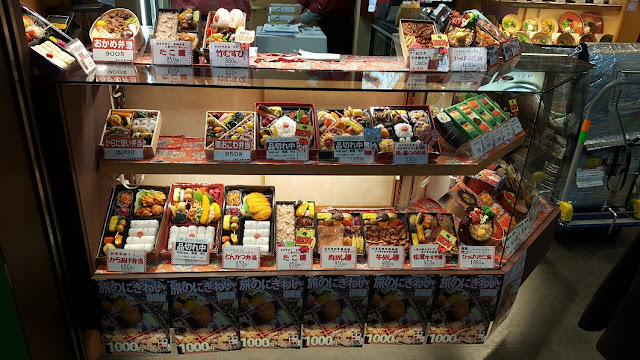 |
| One of the many shops selling Bento sets |
As it was still early for us to check-in to our Airbnb house in Tofukuji (just 1 train station away from here), we had an early lunch in the station first. We went to a restaurant called Tachibana (旬彩和食 たちばな) located along the Nanbokujiyuturo (Pedestrian Walkway 南北自由通路) at the 2nd Floor.
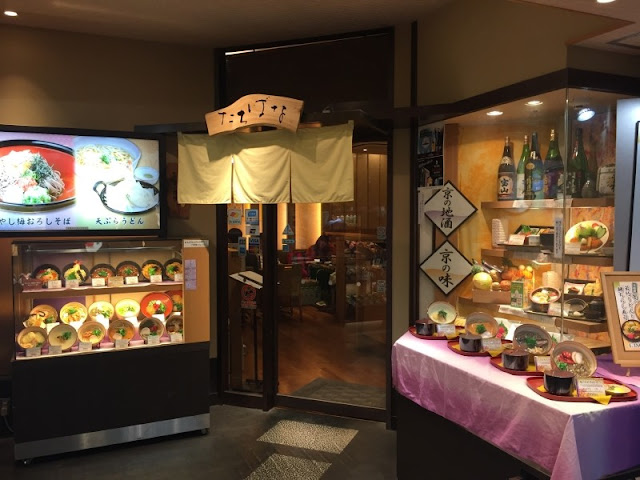 |
| Tachibana (Source: Photo from blog.livedoor.jp) |
The restaurant is not very big, but they still managed to store our big luggage in a corner of their store. They have English menu and the staff could speak English too, thus it wasn't too difficult to place our orders. Some of our orders include the Sashimi Rice Set and the Tempura Soba Set. Personally, I had the Sashimi Rice Set, which was served with salmon, tuna and yellowtail sashimi, chawanmushi, pickled vegetables, cooked salmon, beancurd, miso soup and mochi dessert. Everything was great, but only the cooked salmon does not taste good.
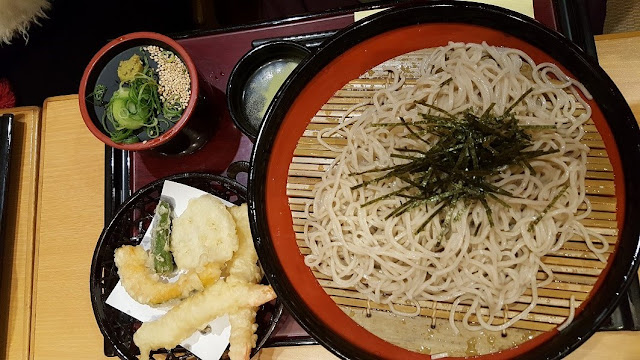 |
| Tempura Soba Set |
 |
| Sashimi Rice Set |
Airbnb at Tofukuji (東福寺)
After our lunch, we went to the platform of Track 8, 9 and 10 for the JR Nara Line, to take the local train to Tofukuji JR Station (東福寺駅). As it is just one station away, the ride duration is very short.
 |
| Tofukuji JR Station |
The area around Tofukuji JR Station (東福寺駅) is mainly residential, which the only commerce activities are along the main street outside the station. From the station, we walked for a short distance and reached our Airbnb house, where we met the host who was still cleaning the house.
The house is entirely decorated in a traditional Japanese style, with Tatami and wooden flooring. The house has 2 storey. The lower level consists of the main dining/gathering space that is equipped with a Kotatsu (table with covered blanket and heater), kitchen, laundry area, toilet and bathroom. The upper level consists of 2 bedrooms with futon beds. The host was very nice to provide us with teabags, snacks, sweets and a notebook as gift.
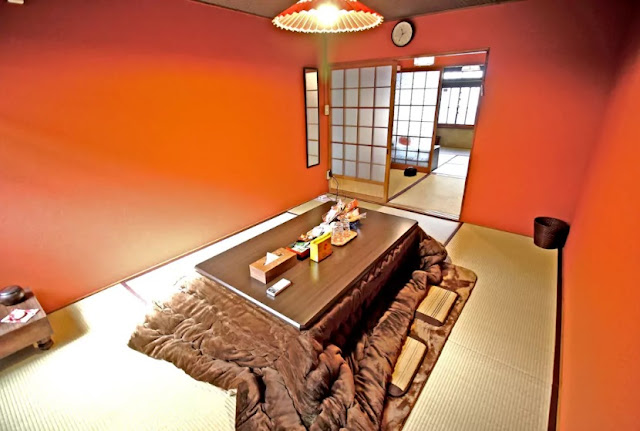 |
| The dining area with Kotatsu (Source: Photo from Airbnb.com) |
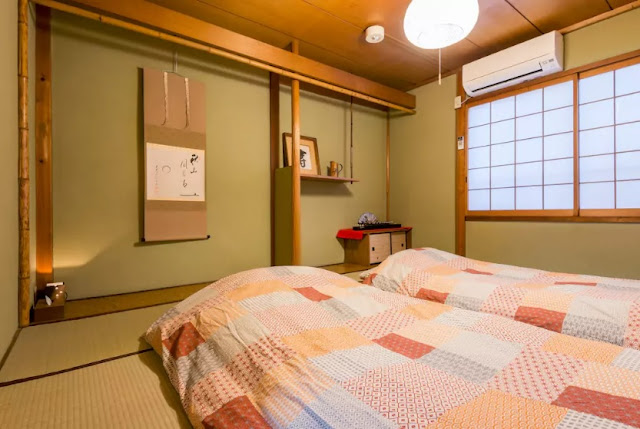 |
| The bedroom with Futon beds (Source: Photo from Airbnb.com) |
Fushimi Inari Shrine (伏見稲荷大社)
After we deposited our luggage at the house, we made our way back to the Tofukuji JR Station (東福寺駅) again. From there, we took the train on the JR Nara Line to Inari JR Station (稲荷駅), to visit our first attraction of the day,
Fushimi Inari Shrine (伏見稲荷大社). The shrine is a very popular tourist attraction among foreigners and locals, which is one of the must-visit attraction in Kyoto. The shrine is dedicated to Inari, which is the God of Rice. One of the most striking feature of the shrine is the thousands of Torii (traditional Japanese gate) along the route uphill, which had also been featured in the famous movie "Memoirs of a Geisha". At the Inari JR Station (稲荷駅), it was packed with people, all trying to make their way to the Fushimi Inari Shrine (伏見稲荷大社), which is located just opposite the station.
 |
| Fushimi Inari Shrine main entrance |
After passing the Main Gate (Romon 楼門), we could see the Main Shrine (Honden 本殿), where visitors made their prayers.
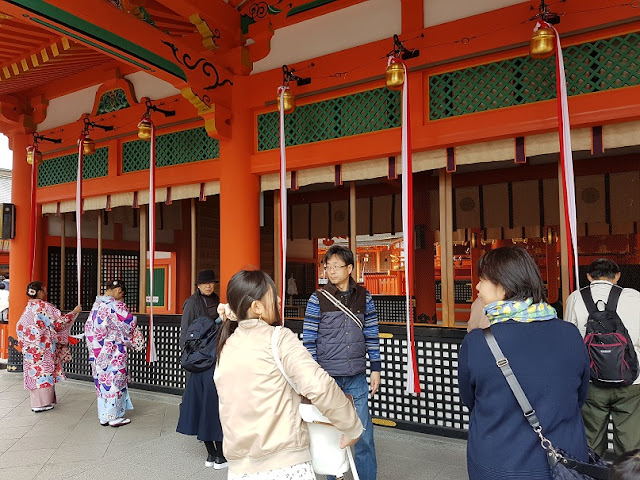 |
| Prayers at the Main Shrine |
Going further uphill, we could see several statues of foxes, which are regarded as the messengers of the God.
 |
| A pair of fox statues |
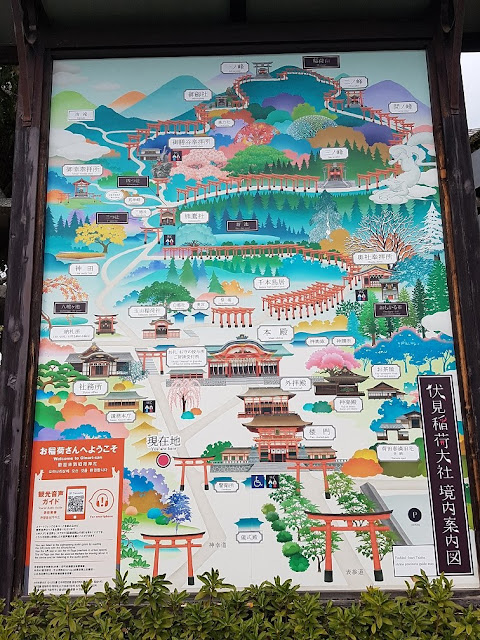 |
| The area map |
After further walking, we had finally reached the start of the "1000 Torii Gates 千本鳥居". Each of the red-coloured Torii is donated by a Japanese business or organisation, which the date and the name of business or organisation will be inscribed onto the gate. It is quite an unique and impressive experience taking photos within the Torii pathway, despite the challenge of the large crowd passing along the path blocking your view.
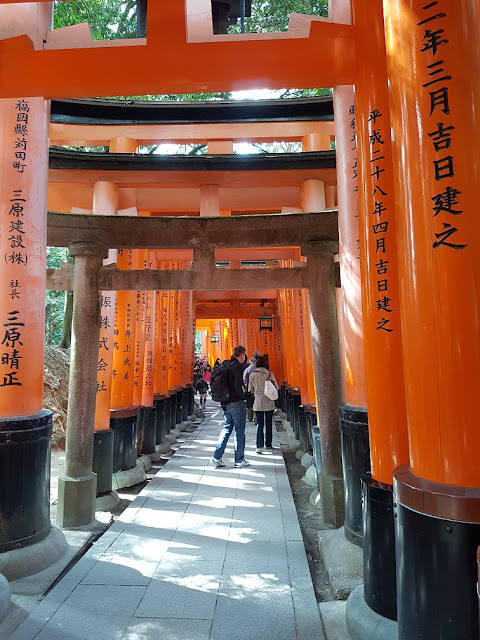 |
| 1000 Torii Gates |
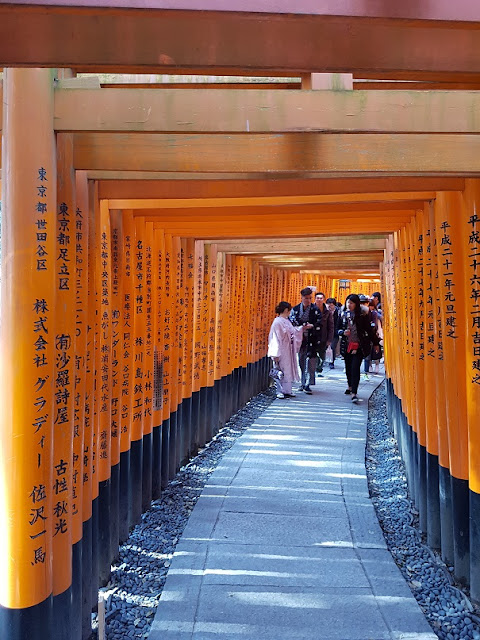 |
| The impressive 1000 Torii Gates pathway |
We continued to walk along the Torii pathway until we reached the small Okusha Shrine (奥社奉拝所), where there's a restroom nearby and shops selling refreshments and prayer charms. We decided not to proceed further uphill, as it is another one hour walk along the Torii pathway to the top of the mountain. We rested for a while before making our way down the same route. Back to the Main Shrine (Honden 本殿), we went into an adjacent street, where there were many small stalls selling snacks. Probably due to our early lunch, some of us still felt hungry, which we bought some of the snacks (matcha mochi, fried chicken popcorn and beef steak etc).
 |
| Mochi on sale |
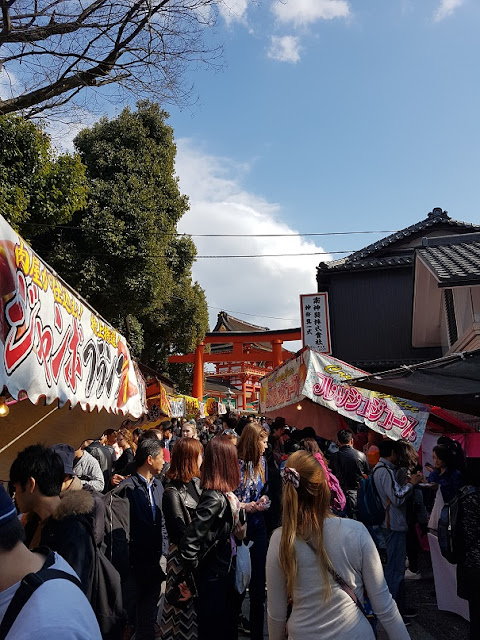 |
| The busy food street |
After the snacks, we departed for the Inari JR Station (稲荷駅).
Kiyomizu-dera Temple (清水寺)
Our next attraction to visit is the
Kiyomizu-dera Temple (清水寺), which is an UNESCO World Heritage Site, another must-visit place in Kyoto. From the Inari JR Station (稲荷駅), we took the local train on the JR Nara Line to Kyoto Station (京都駅). We then made our way to the bus interchange to take the Kyoto City Bus 100 at Stand D1. Bus 100 is one of the few tourist dedicated bus service, which the route will pass by museums, temples and other popular attractions. In the bus, there's recorded introduction and announcements in Japanese, English and Mandarin language, so that tourists are able to alight at the correct bus stop. Once we reached the Gojozaka bus stop, we alighted with many others on the bus. We could see large groups of visitors at the traffic junction nearby to make their way to the Kiyomizu-dera Temple (清水寺).
Kiyomizu-dera Temple (清水寺) is located on the hill, which the leading road (Shimizu New Way Chawan-zaka) is narrow and does not allow any big coaches or vehicles to enter. From our location, it is another 800m walk uphill before we can reach the entrance of the temple.
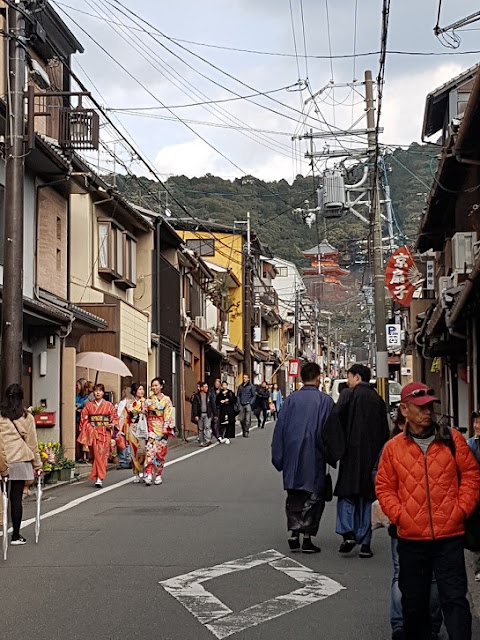 |
| Uphill route towards Kiyomizu-dera Temple |
Although the walk is long, it isn't boring as both sides of the road are filled with apparel and souvenir shops, cafes and restaurants, which we stopped by occasionally to visit some of the shops. We also realised there are several shops that provided
Kimono rental service, which includes hairdo and accessories. Apparently, this is very popular among tourists, which we could see several groups of foreign tourists dressed in Kimono to visit the temple.
Kiyomizu-dera Temple (清水寺) is Buddhist temple dedicated to the Bodhisattva Kannon, also widely known to the Chinese as Guanyin, Goddess of Mercy. The temple was founded in 778, and later reconstructed in 1633 to its current state. Kiyomizu means "pure water" in Japanese, which got its name from the waterfall within the compound.
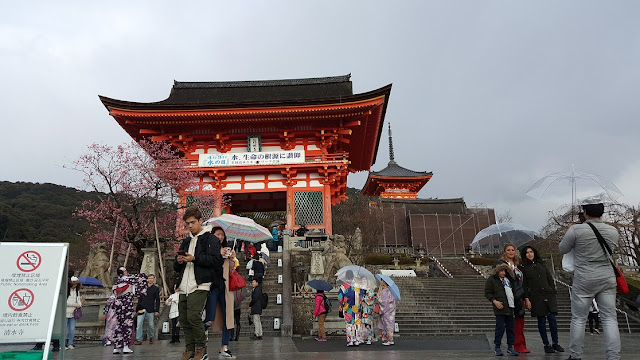 |
| Entrance of Kiyomizu-dera Temple |
When we were there, parts of the temple were closed for renovation. The West Gate (Sai-mon 西門), just beside the Main Gate (Nio-mon 仁王門), was barricaded for renovation. However, we could still see the beautiful 3-Tiered Pagoda (三重塔). Along the way, we could see some of the cherry trees had already partially bloomed, which we stopped by to take photos.
 |
| Ladies dressed in Kimono passing in front of the 3-Tiered Pagoda |
 |
| Another view of the 3-Tiered Pagoda with the Sakura (Cherry Blossom) |
Further up, we could see people making prayers inside the Zuigu-do Hall (随求堂), famous for wishes on matchmaking and child birth. So far till this area, it was free to enter.
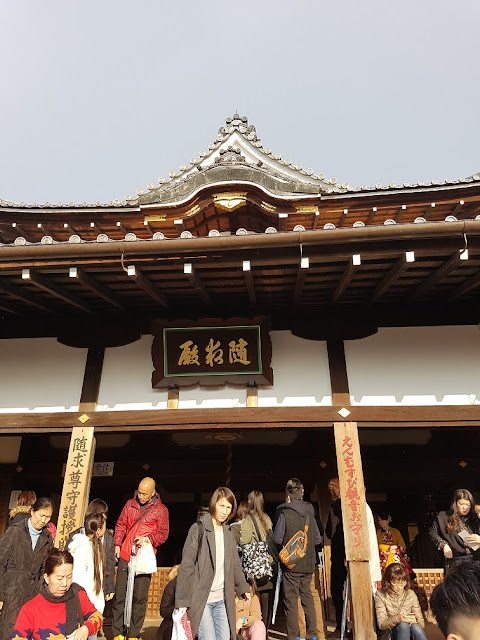 |
| Zuigu-do Hall |
To enter the Main Hall (Hondo 本堂) and further, an entrance fee of Yen 300 per adult is required.
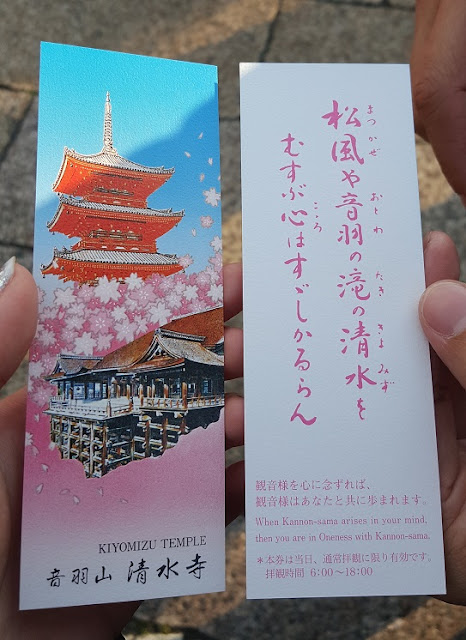 |
| Entrance tickets to the temple proper |
The Main Hall (Hondo 本堂) is the place where the statue of the Eleven-headed Thousand-armed Kannon Bodhisattva is enshrined. The interior does not have any lighting, which is quite dark.
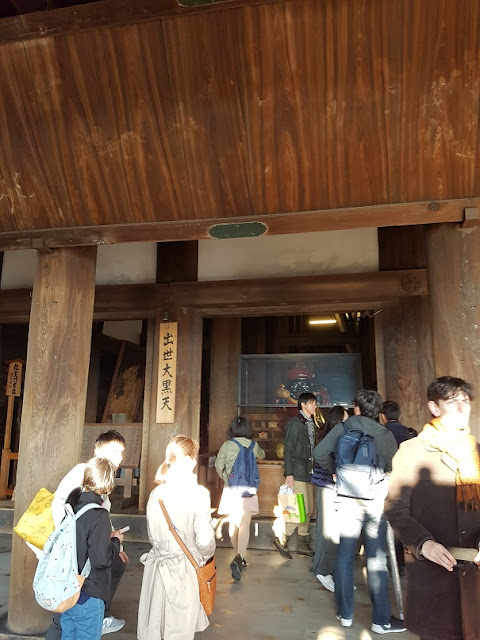 |
| Main Hall (Hondo) |
The hall is built on top of a steep slope, which large columns of wooden pillars are used to support the stage area. It is known that no nail is used in the wooden structure. The slope facing side of the hall was barricaded for renovation. After this, we could see the Okuno-in Hall (奥の院) and the Otowa Waterfall (Otowa no taki 音羽の瀧) at the bottom of the slope. The Okuno-in Hall (奥の院) is constructed on top of the slope too (directly above the Otowa Waterfall), similar to the Main Hall. Over there, it provides a magnificent view of the Main Hall and the Kyoto city centre.
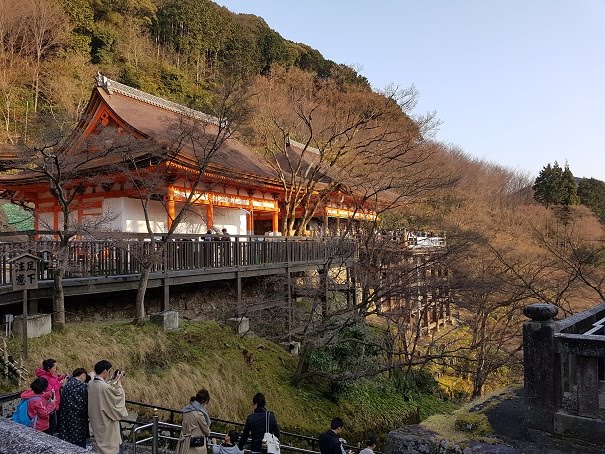 |
| Okuno-in Hall |
We walked down the long flight of stairs towards the Otowa Waterfall (Otowa no taki 音羽の瀧). There are 3 channels of water fall into a pond, which visitors could catch and drink the water, supposedly to be able to grant wishes. As there was a long queue of people trying to do that, we did not join in and only took photos around area.
 |
| Otowa Waterfall (Otowa no taki) |
 |
| Visitors catching the "waterfall" |
On the way to the exit, we had a photo taking at the pond, which had a beautiful backdrop of the 3-Tiered Pagoda (三重塔) and the blossomed cherry trees.
 |
| Scenic view at the pond |
Gion (祇園)
After the temple visit, next on our itinerary was to visit
Gion (祇園) district. We had to walk downhill through the street (Matsubara Dori), which was bustling with shops selling souvenirs, snacks, ice-cream, tea house, cafes and restaurants.
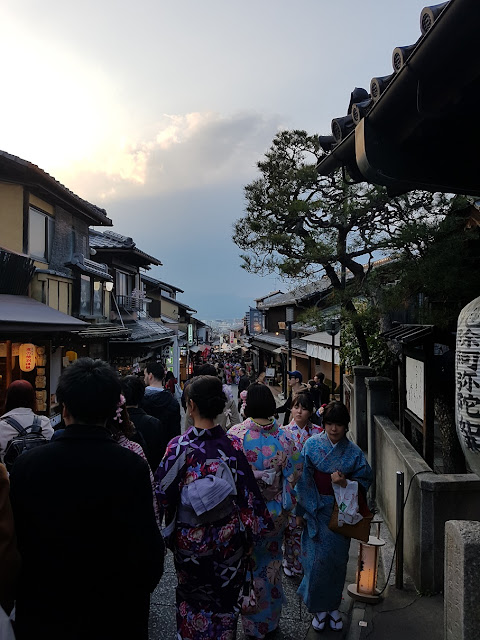 |
| The busy street of Matsubara Dori |
After this, it was another long walk towards the Kennin-ji Temple (建仁寺) and we entered the street Hanamikoji Dori, which is considered the heart of the Gion (祇園) district.
Gion is a very well-known Geisha (also locally known as Geiko) and traditional entertainment district in Japan, since the ancient days. Along Hanamikoji Dori, both sides of the street are flanked by traditional-styled houses called Machiya. Today, they are high-end tea houses and restaurants, where the Geisha would dance and sing in the private sessions. It was said that if we were lucky, we might be able to see Geisha on the street. However, we did not have that luck and saw none, except a lot of tourists.
 |
| Gion District (Hanamikoji Dori) |
There's also a theatre nearby called Yasaka Hall Gion Corner, where there's daily performance on Japanese traditional arts. It is a popular tourist attraction in Kyoto, a good place for people who wanted to learn more about the Japanese traditional arts.
Gion Tsujiri Teahouse (祇園辻利)
Our original plan initially was to walk further north to the Shirakawa Canal, which is a famous scenic area for photo taking. But since it was already late and dark, we had decided to give it a miss. We skipped to the next location and walked to the nearby Gion Tsujiri Teahouse (祇園辻利) (which has oversea branches in Singapore and Malaysia too), which is a very famous brand in Kyoto specialising on Matcha related snacks and desserts, having more than 150 years of history.
 |
| Gion Tsujiri Teahouse |
The store has 2 levels. Level 1 has a counter that sells takeaway Matcha, ice-cream and desserts. Further inside is a display of Matcha snacks and tea leaves nicely packed and suitable for tourists like us to buy as souvenirs. We shopped around and bought some of their popular Matcha biscuits and cookies.
 |
| (Source: Photo from luci.co.jp) |
Level 2 is their seat-in area, where customers can enjoy the tea and desserts in the store. When we were there, there was a very long queue waiting to get a seat in Level 2.
Issen Yoshoku (壹銭洋食)
After the souvenir shopping, we continued further down the street to a small restaurant called Issen Yoshoku (壹銭洋食) to eat their Kyoto-style Okonomiyaki, which is the only thing they sell in the shop.
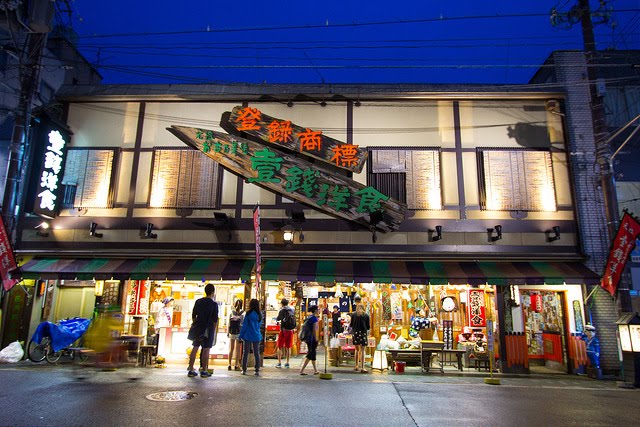 |
| Issen Yoshoku (Source: Photo from Food Touring) |
 |
| Humorous figurines of the dog and the boy |
We were lucky to get a large table without much waiting and we ordered 2 plates of the Okonomiyaki as snacks for sharing, as we planned to have our proper dinner afterwards. The Okonomiyaki looks different from the typical ones we used to eat. It looks more like an egg wrap than pancake. However, it still tasted good and had a generous serving of ingredients, including fish paste, minced beef and shrimp.
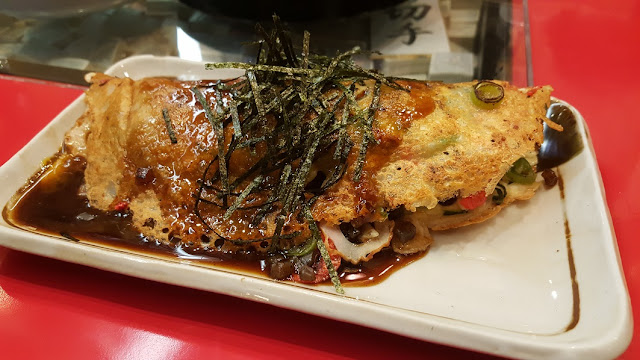 |
| The main dish - Okonomiyaki |
Dinner at Kotoshi @ Pontocho (ことし @ 先斗町)
We departed for our last stop of the day, dinner at Pontocho (先斗町). We were all very tired after a day long of walking. We followed along the street Shijo Dori and cross over to the other side of the Kamogawa River. From there, it was just a short distance before we turned into the narrow and long alley, which stretches from Shijo Dori to Sanjo Dori. Both sides of the alley are packed with many restaurants selling Japanese, fusion and western food. The price range of the food here are generally cheaper than in Hanamikoji Dori located at the heart of Gion. However, there are also restaurants on the high end price range too. Restaurants on the right hand side would have riverfront dining options facing the Kamogawa River.
As we walked along, we randomly chose a restaurant called Kotoshi (ことし), which specialise on French fusion and grill cuisine.
 |
| Kotoshi (Source: Photo from kotoshi.jp) |
They had English menu, so it was easy for us to determine what was available inside. We had to leave our shoes at the shoe rack and were then led to the 2nd level.
 |
| Our seating area at Level 2 |
We ordered a variety of food, such as Chicken Sukiyaki, Pork Shabu-Shabu, Chicken/Pork/Beef grill on hot plate. The food was delicious and the serving was just nice.
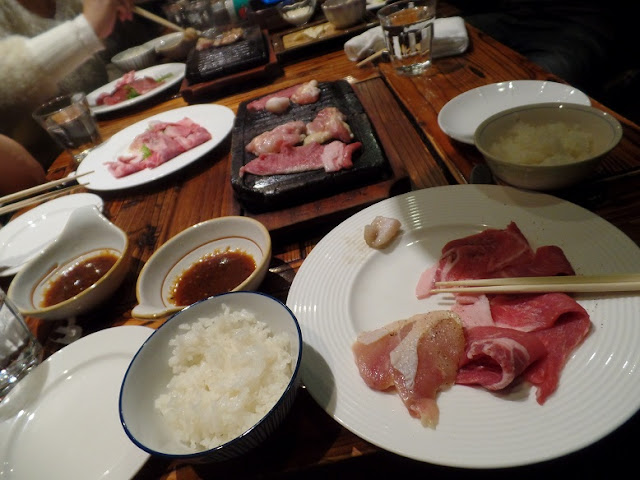 |
| The grill set |
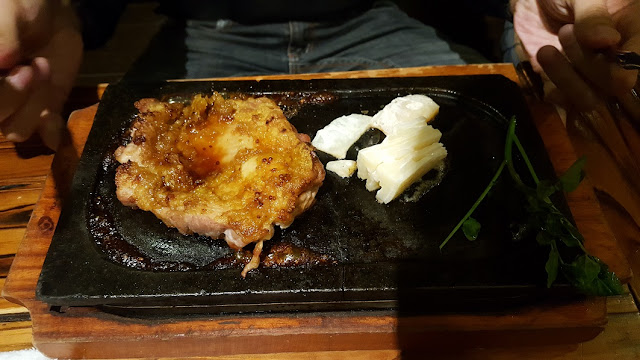 |
| Chicken Grill |
After the meal, we walked to the Gion-Shijo Station (祇園四条駅) to take the train on the Keihan Main Line back to Tofukuji Station (東福寺駅) and from there, returning to our Airbnb house.




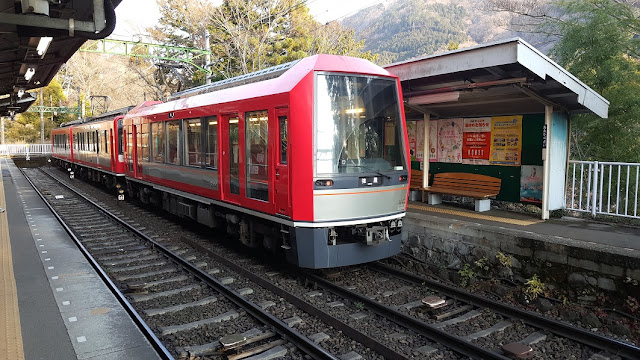














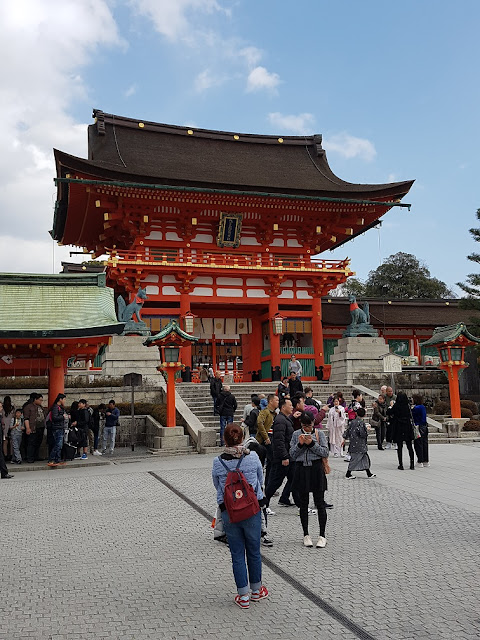
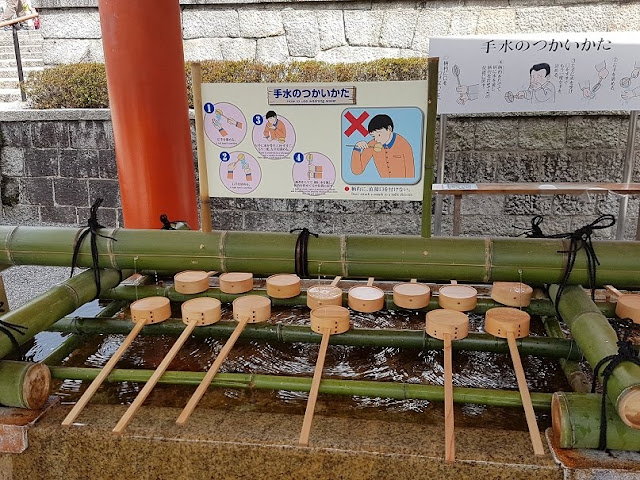


























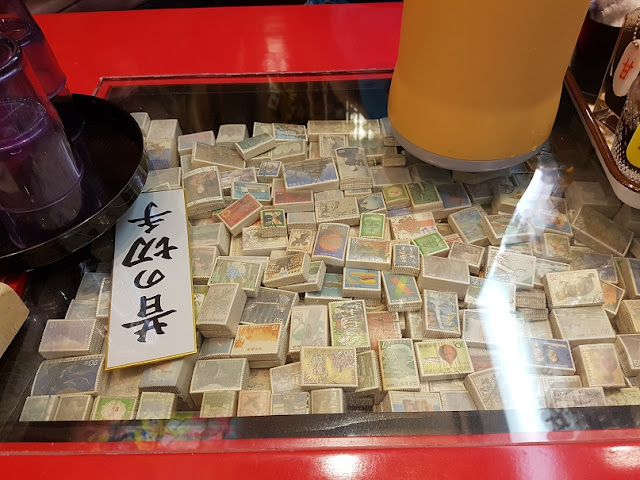




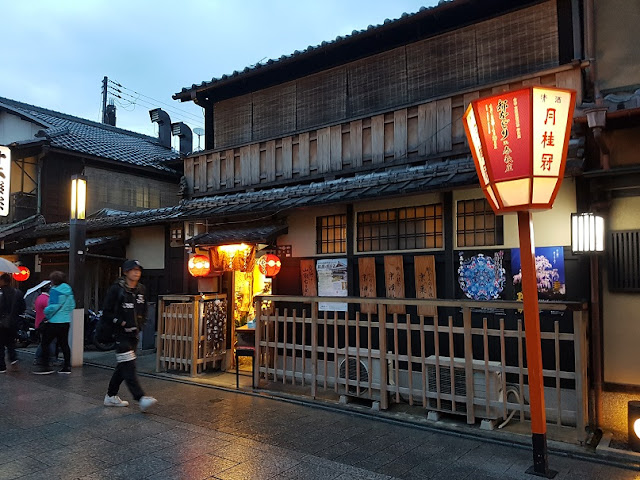




No comments:
Post a Comment